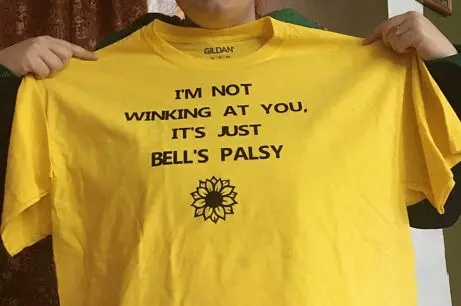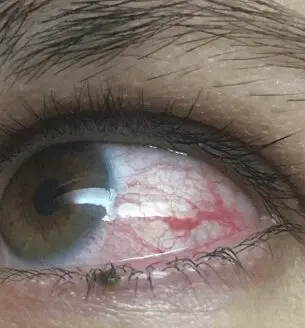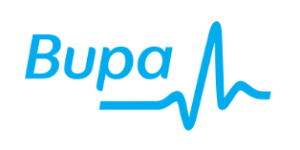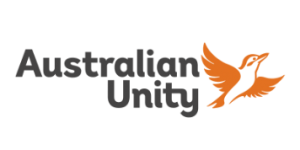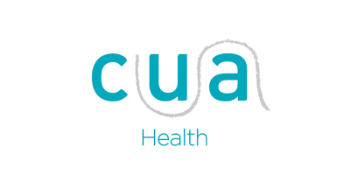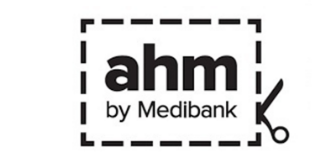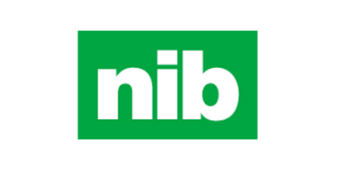Bell’s palsy is a frightening and disfiguring condition – Low Level Laser is a game changer for rapidly resolving the nerve swelling responsible for facial paralysis. Let our expert Myotherapists help you regain control of your face – using the LATEST science based solutions. The Knead Myotherapy Bells Palsy protocol is only effective in the first 6-8 weeks since symptom onset. If you have has symptoms for more than 3 months our protocol will not be useful.
This article is a comprehensive guide to helping you overcome the frustration and disfigurement of Bell’s palsy – quickly. It describes:
- What Bell’s palsy is.
- Who is likely to get Bell’s palsy.
- How you get it.
- What Bell’s palsy feels like.
- How Long it lasts.
- What you should do to resolve it.
- What you should not do.
- What expert Bell’s palsy treatment involves.
Do not delay treatment – early intervention improves outcomes. Low Level Laser rapidly accelerates the recovery time from Bell’s palsy.
Book your Initial Bell’s Palsy treatment
What is Bell’s palsy?
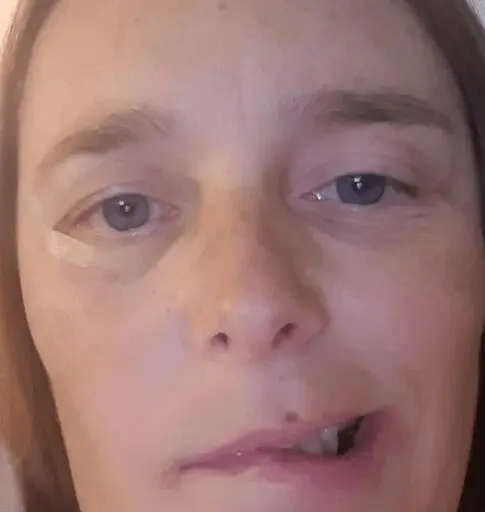
The individual in the picture is trying to smile wide – notice that her right eye is sagging and watering slightly.
- Bell’s palsy (Facial Palsy) is a debilitating condition involving an abrupt one sided paralysis of the face – it is not a stroke.
- Bell’s palsy is caused by inflammation and swelling of the facial nerve – which is responsible for facial expression, sensation and eyelid movement.
- The onset is sudden with only minor symptoms before the paralysis – headache, swelling behind the ear and watering of the affected eye.
People often mistake Bell’s palsy for the aftermath of a stroke. If you have any kind of undiagnosed facial paralysis you should call 000 or present to a hospital immediately. Optimal resolution of Bell’s palsy requires the administration of cortisone within 3 days of symptom onset.
Who gets Bell’s palsy?
- The two main age ranges affected by Bell’s palsy are 30-50 year olds and 60-70 year olds – however children may also be affected.
- There are approximately 40 cases per 100,000 new cases of Bell’s palsy annually.
- It is statistically unlikely for Bell’s palsy to return (<8.3%).
How do you get Bell’s palsy?
A viral infection (herpes) penetrating the facial nerve and causing swelling and inflammation is the cause of Bell’s palsy. The infection causes the facial nerve to swell and become entrapped by hard structures of the skull, causing a reduction of nerve conductivity. The symptoms can be mild, but most often are somewhat disfiguring.
Book your Initial Bell’s Palsy treatment
How does it feel?
The symptoms of Bell’s palsy include:
- Sudden one sided facial droop
- difficulty closing

the affected eye
- excessive tears in the affected eye (not closing the eye leads to dryness and tear production)
- one sided mouth drop (lopsided smile)
- a loss of facial expressions
- drooling
- challenges drinking and consuming food
- pain or sensitivity around the affected area
- headache
- reduced sensitivity to taste
- Neck pain and shoulder tension
Book your Initial Bell’s Palsy treatment
How long does Bell’s Palsy last?
- Without the use of Low Level Laser, Improvements usually occur within 6 weeks and a complete recovery within 9 months. In our experience using Low Level Laser consistently in the early stages provides results FAR superior to this.
- Getting treatment within the first week of symptoms leads to an 88% likelihood of recovery.
- Treatment commencing between 7-14 days has an 83% likelihood of recovery.
- Treatment that does not start until 14-21 days has a 61% chance of recovery
- The condition usually resolves completely given time (71% within 6 months).
- Approximately 23% of individuals who suffer Bell’s palsy are left with ongoing symptoms such as facial weakness, abnormal tears (crocodile tears), one sided facial spasm and involuntary twitches.
What should you do to resolve Bell’s palsy Brisbane?
- Getting medical assessment as soon as symptoms start.
- Receiving timely cortisone treatment within 3-7 days of symptoms
- Early low level laser sessions closely spaced together after receiving your first dose of cortisone.
- Wearing sunglasses during the day.
- Taping your eye shut if the eye is drying out.
- Regularly using prescription eye drops.
If you have been diagnosed with Bell’s palsy it is IMPERATIVE that you commence steroid treatment immediately. The next most important thing is to receive at least 3×30 minute low level laser sessions within a few days of cortisone and close to each other – the combination is extremely potent at rapidly resolving Bell’s palsy symptoms.
Low Level Laser is a game changer for resolving Bell’s palsy symptoms.
Book your Initial Bell’s Palsy treatment
What shouldn’t you do?
- Do not avoid your GP and a diagnosis. Any facial paralysis is a serious and potentially life threatening condition. A GP will quickly ascertain if you have stroke symptoms or Bell’s palsy by observing which structures are suffering paralysis (strokes do not affect the ability to squint).
- Do not delay getting cortisone. Administration of cortisone within 7 days of symptom onset leads to a faster, more complete recovery (88% likelihood of full recovery).
- Do not waste time getting electro therapy or acupuncture without laser. Acupuncture is effective for many conditions, but has no scientifically meaningful data for the treatment of Bell’s palsy.
How is the condition treated?
- The evidence overwhelmingly suggests that ingestion of oral steroids within the first 72 hours of paralysis will greatly assist with a timely recovery.
- The use of lubricating eye drops is essential to protect the cornea.
At Knead Myotherapy Brisbane we incorporate the use of low level laser to rapidly reduce the neural inflammation and assist’s to resolve symptoms quickly. There are numerous studies demonstrating the efficacy of low level laser for nerve inflammation and in our experience, application of laser within a few days of cortisone can assist in the rapid resolution of Bell’s palsy. Symptoms such as eye watering should reduce significantly after the first low level laser session. We recommend 3 x 30 minute Myotherapy treatments with laser spaced approximately 2-3 days apart. That’s all it takes if you act quickly.
Electro therapies have also been shown to improve functional outcomes at 2 months, Your Myotherapist may use electro-needling and other electro modalities to improve functional movements.
Related Posts

Wry Neck Brisbane
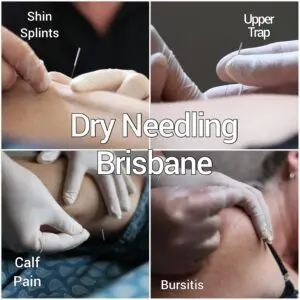
Dry Needling Brisbane
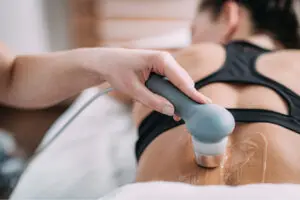
Low level laser therapy
Frequently Asked Questions (FAQs)
When does Bell's palsy go away?
- Without the use of Low Level Laser, Improvements usually occur within 6 weeks and a complete recovery within 9 months. In our experience using Low Level Laser consistently in the early stages provides results FAR superior to this.
- Getting treatment within the first week of symptoms leads to an 88% likelihood of recovery.
- Treatment commencing between 7-14 days has an 83% likelihood of recovery.
- Treatment that does not start until 14-21 days has a 61% chance of recovery
- The condition usually resolves completely given time (71% within 6 months).
- Approximately 23% of individuals who suffer Bell’s palsy are left with ongoing symptoms such as facial weakness, abnormal tears (crocodile tears), one sided facial spasm and involuntary twitches.
Who treats Bell's palsy?
If you have been diagnosed with Bell’s palsy it is IMPERATIVE that you commence steroid treatment immediately – your GP can provide these. The next most important thing is to consult with a Myotherapist to receive at least 3×30 minute low level laser sessions within 9 days of each other. Low level laser has been proven to boost the immune response to the herpes virus while simultaneously reducing neural swelling.
Low Level Laser is a game changer for resolving Bell’s palsy symptoms.
Why does bell's palsy cause ear pain?
The swollen nerve (the facial nerve) emerges from the brain and skull just behind the ear, this is an area where the nerve can compress against the skull and become irritated.
Steroids for bell's palsy?
If you have been diagnosed with Bell’s palsy it is IMPERATIVE that you commence steroid treatment immediately. Early treatment greatly reduces recovery time and increases the likelihood of full recovery.
Is bell's palsy a stroke?
Bell’s palsy is not a stroke, it does not increase the risk of stroke and it is not life threatening. A stroke occurs inside the brain, Bells palsy is the result of an infection in nervous tissue that has left the brain.
Can bell's palsy be reversed?
In most circumstances yes.
- Without the use of Low Level Laser, Improvements usually occur within 6 weeks and a complete recovery within 9 months. In our experience using Low Level Laser consistently in the early stages provides results FAR superior to this.
- Getting treatment within the first week of symptoms leads to an 88% likelihood of recovery.
- Treatment commencing between 7-14 days has an 83% likelihood of recovery.
- Treatment that does not start until 14-21 days has a 61% chance of recovery
- The condition usually resolves completely given time (71% within 6 months).
- Approximately 23% of individuals who suffer Bell’s palsy are left with ongoing symptoms such as facial weakness, abnormal tears (crocodile tears), one sided facial spasm and involuntary twitches.
Can bell's palsy be cured?
In most circumstances yes.
- Without the use of Low Level Laser, Improvements usually occur within 6 weeks and a complete recovery within 9 months. In our experience using Low Level Laser consistently in the early stages provides results FAR superior to this.
- Getting treatment within the first week of symptoms leads to an 88% likelihood of recovery.
- Treatment commencing between 7-14 days has an 83% likelihood of recovery.
- Treatment that does not start until 14-21 days has a 61% chance of recovery
- The condition usually resolves completely given time (71% within 6 months).
Approximately 23% of individuals who suffer Bell’s palsy are left with ongoing symptoms such as facial weakness, abnormal tears (crocodile tears), one sided facial spasm and involuntary twitches
Can bell's palsy get worse?
Technically, yes. Bell’s palsy that last longer than 3months can cause neuroplastic change – meaning the brain and nervous system become better at making inflammation and turning off the regions that aren’t working. This is a gradual process.
Can bell's palsy kill you?
Bell’s palsy is non life threatening.
How bell's palsy affects the eye?
- The worst affects of Bell’s palsy on the eye occur because the eyelid does not close and blinking is inhibited. In the early stages this will lead to excessively watery eyes.
- Changes to the salivary glands from the altered facial nerve can cause a phenomenon known as crocodile tears – tears forming from salivation.
- The eye can dry out and become susceptible to debris and scratching. It is important to protect the eye from bright light and particles and maintain lubrication with some form of artificial tear.
How does bell's palsy go away?
- Bell’s palsy is considered a self- limiting condition. However studies suggest that upto 27% of individuals will have ongoing symptoms. Early treatment is the key to rapid recovery – getting cortisone is the single most important factor an individual can do to reduce the duration of symptoms.
- Without the use of Low Level Laser, Improvements usually occur within 6 weeks and a complete recovery within 9 months. In our experience using Low Level Laser consistently in the early stages provides results FAR superior to this.
- Getting treatment within the first week of symptoms leads to an 88% likelihood of recovery.
- Treatment commencing between 7-14 days has an 83% likelihood of recovery.
- Treatment that does not start until 14-21 days has a 61% chance of recovery
- The condition usually resolves completely given time (71% within 6 months).
How to know when bell's palsy is improving?
The benchmarks of improvement will vary from person to person – less watering of the eye, being able to close the eye, not drooling because the mouth is working better, less ear pain – these are common features of someone who has had a few Low Level Laser interventions.
Is bell's palsy permanent?
Not usually, but in up to 27% of cases, there is some level of ongoing symptoms. Early treatment within the first week improves likelihood of complete recovery to 88%. Waiting till 3 weeks lessens the likelihood to 61%.
What causes bell's palsy in a child?
Bell’s palsy is caused by the Herpes virus affecting the seventh cranial nerve – the facial nerve. Exposure to herpes when your immune system is weak is the likely explanation.
Is bell's palsy hereditary?
Bell’s palsy is caused by the Herpes virus affecting the seventh cranial nerve – the facial nerve. Exposure to herpes when your immune system is weak is the likely explanation.
Is bell's palsy genetic?
Bell’s palsy is caused by the Herpes virus affecting the seventh cranial nerve – the facial nerve. Exposure to herpes when your immune system is weak is the likely explanation.
What does bell's palsy look like?
Individuals affected with Bells palsy will manifest symptoms differently depending on the severity of the infection. It is always one sided, usually affecting the eye and the mouth. An individual asked to smile will not be able to raise the mouth on the affected side. An individual asked to raise their eyebrows will not be able to raise the eyebrows on the affected side. The eye on the affected side may look droopy and be watering.
When bell's palsy doesn't go away?
- Bell’s palsy is considered a self- limiting condition. However studies suggest that upto 27% of individuals will have ongoing symptoms. Early treatment is the key to rapid recovery – getting cortisone is the single most important factor an individual can do to reduce the duration of symptoms.
- Without the use of Low Level Laser, Improvements usually occur within 6 weeks and a complete recovery within 9 months. In our experience using Low Level Laser consistently in the early stages provides results FAR superior to this.
- Getting treatment within the first week of symptoms leads to an 88% likelihood of recovery.
- Treatment commencing between 7-14 days has an 83% likelihood of recovery.
- Treatment that does not start until 14-21 days has a 61% chance of recovery
- The condition usually resolves completely given time (71% within 6 months).
Can bells palsy be caused by Covid 19?
Bells palsy is caused by the herpes virus. At the time of publication, there are instances of individuals receiving an American COVID-19 vaccine that have developed Bells palsy – it is too early to determine the severity at this time. It is possible that individuals with weakened immune systems who have been exposed to herpes and receive the vaccine are manifesting symptoms because the vaccine further weakens their immune system for 48-72 hours after application.
Are bell's palsy and trigeminal neuralgia related?
No. But there have been studies that have shown approximately 50% of Bell’s palsy sufferers have some inflammation of the trigeminal nerve.
How is bell's palsy differentiate from stroke?
Bells palsy only affects one side of the face. After a stroke eye movement is not affected, however Bells palsy impairs eye movement. A stroke occurs in the brain (Central nervous system), the location of the herpes infection that is causing the swelling is in neural tissue that is outside of the cerebrum (peripheral nervous system).
Who treats Bell's palsy Brisbane?
Myotherapist Roger Morelli at Knead Myotherapy Brisbane has experience rapidly resolving Bell’s palsy using the latest scientific methods – including Low Level Laser. Low Level Laser is a game changer for rapidly resolving the nerve swelling responsible for facial paralysis and improving the immune response to the herpes virus responsible for the neural swelling causing the paralysis.
https://www.healthdirect.gov.au/bells-palsy
https://www.racgp.org.au/afp/2016/november/a-general-practice-approach-to-bell%E2%80%99s-palsy/
https://www.rch.org.au/kidsinfo/fact_sheets/Facial_palsy_Bells_palsy/
https://www.mayoclinic.org/diseases-conditions/bells-palsy/diagnosis-treatment/drc-20370034
https://www.ncbi.nlm.nih.gov/pmc/articles/PMC3152161/
https://edisciplinas.usp.br/pluginfile.php/4614262/mod_resource/content/1/fallah2017.pdf
https://fac.ksu.edu.sa/sites/default/files/27-nmesidiopathic_facial_bell_palsy.pdf
https://www.ncbi.nlm.nih.gov/pmc/articles/PMC3907546/
https://emergencyfoundation.org.au/bells-palsy-trial-in-children/
https://pdfs.semanticscholar.org/8cae/9368bff73560acb9707497a4b86205bbf30d.pdf
http://citeseerx.ist.psu.edu/viewdoc/download?doi=10.1.1.840.6954&rep=rep1&type=pdf

Roger Morelli


Latest posts by Roger Morelli (see all)
- Lymphatic Drainage Massage Benefits - October 18th, 2024
- Lymphatic Compression Pump Therapy Brisbane - October 16th, 2024
- Lymphoedema Brisbane - October 14th, 2024

